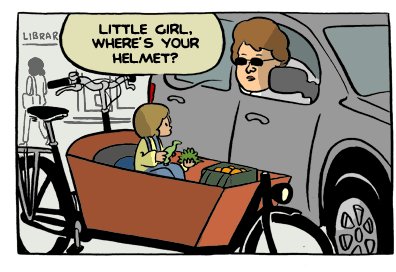Complete places vs. complete streets as a planning principle

Yehuda Moon and the Kickstand Cyclery comic strip, 3/31/2009.
The Seattle Post-Intelligencer has a column about the impact of critical mass in bicycling and how it changes planning. See "Bicyclists are changing our streets and cities." From the article:
A backstage hero of Jeff Mapes' book "Pedaling Revolution: How Cyclists are Changing American Cities" is an intense young bureaucrat named Mia Birk, who put Portland on a "road diet" and created bike lanes across the Rose City.
"The motto was, 'Better to ask forgiveness than permission," joked Mapes. It sums up why a sweeping change in transportation policy has caught hold from New York City to Louisville, Ky., to such "Left Coast" cities as Seattle, Portland and Davis, Calif.
In Portland, where he is a political writer with The Oregonian, Mapes' bike commutes were made safer when the city shut down one entrance ramp to the Hawthorne Bridge that was causing bike-car conflicts.
"A movement has grown slowly, under the radar screen, which people are hardly aware is going on," Mapes told a Tuesday night forum sponsored by the Cascade Bicycle Club. ...
"I've seen in Portland how just an approximate 5 percent share for biking -- more than five times the national average -- has changed the city," writes Mapes. "And I see how learning to ride my bike in the city has changed my life. I still have a car and I still appreciate its utility. But I don't worry about high gas prices, road congestion or lack of parking downtown." ...
Mapes takes us to even more pedal-friendly cities. In Amsterdam, 40 percent of non-walking trips are by bike. He quotes, approvingly, Jack Wolters, the city's top traffic-safety officer: "The target of the police is not to control cyclists and pedestrians. It is to control the most dangerous part, motorcar drivers."
Such attitudes can make motorists skin crawl on this side of the Atlantic Ocean. "Some people don't like bikes on the road," Mapes said Tuesday. "Transition is hard."
In my forthcoming set of pieces on a transportation vision plan for DC, one of the organizing principles is what I call "complete places." Typically, in transportation there is the concept of "complete streets," which are defined as:
The streets of our cities and towns ought to be for everyone, whether young or old, motorist or bicyclist, walker or wheelchair user, bus rider or shopkeeper. But too many of our streets are designed only for speeding cars, or worse, creeping traffic jams. They’re unsafe for people on foot or bike — and unpleasant for everybody. (From the Complete Streets website.)
Really, what we need are "complete" livable "places"--not just the infrastructure of the streets and sidewalks and transit, but the entire physical, social, and economic environment, from a quality commercial district in walking distance full of functioning, interesting businesses to well-functioning neighborhood schools, etc.
I don't know what this should be called, PPS calls it "placemaking." I think you could call it "place-oriented development" (rather than "transit-oriented development") but that seems so cold--POD? Right now, I just call it "complete places."
When you focus on "complete" "streets" I think you still end up focusing more on mobility and automobility than you do on livability. Streets aren't just for mobility, they are places where people live, where they socialize, where they shop and conduct business, etc.
See "Pride of Place," about the Project for Public Spaces and placemaking, from Governing Magazine, and Dan Burden's 12 points of "What makes a community walkable?"




0 Comments:
Post a Comment
<< Home